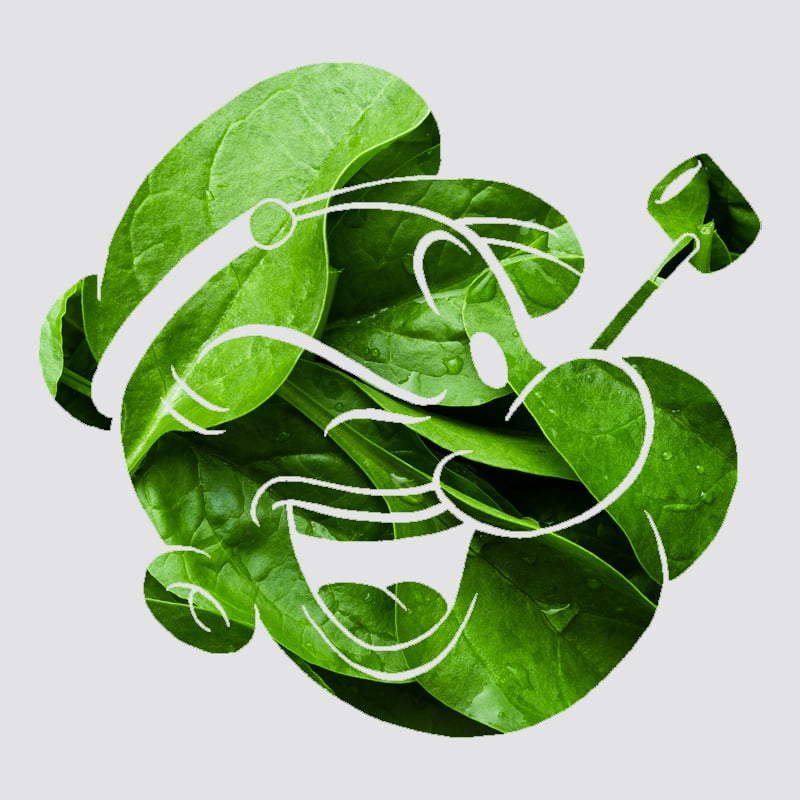By Circle Editorial Team

How many of you remember Popeye the sailor man? The trope of eating spinach (straight from a can, mind you) to gain superhuman strength has become a lasting image in pop culture. Spinach was, by all accounts, the OG superfood.
But is the spinach worth that title? Or is the leafy green’s superpowers more fiction than fact? Just how healthy is spinach?
Claim: Super Strength
While cartoonishly overexaggerated, the physical transformation that Popeye undergoes after chugging a can of spinach is an iconic image that isn’t too dissimilar to the feats of Superman, just without the heat beams and frost breath.
And it would seem that there is a basis for that reference - Ecdysterone, the main compound found in spinach extracts. Researchers found that those who took ecdysterone saw their performance improve by three times as much as those who did not. Effectively a naturally sourced performance-boosting supplement, the researchers recommended that ecdysterone be included in the doping ban. Cue the “Popeye was right” headlines.
Claim: “Iron Man X Groot”
American nutritionist Henry Clapp Sherman claimed that eating plants rather than meat, liver and eggs was the most effective way for us to get iron from natural dietary sources.
100 grams of raw spinach contains 2.7 milligrams of dietary iron. The Health Promotion Board recommends 8 to 18 milligrams of iron per day, depending on the demographic. After doing some quick math, that 100 grams of raw spinach would in theory fulfill between 15 to 34 percent of that daily recommendation.
What About Iron?
As an essential component of haemoglobin, iron supports muscle metabolism and healthy connective tissue. It is also necessary for physical growth, neurological development, cellular functioning, and synthesis of some hormones.
The most common cause of anaemia in Singapore is iron deficiency. Iron-deficiency anaemia affects more women than men, and the risk of iron-deficiency anaemia is highest for women who:
Are pregnant. Pregnant women require additional iron during pregnancy to support fetal development. Severe anaemia during pregnancy could increase the risk of premature birth, a low birth weight baby and postpartum depression.
Have heavy menstrual periods. Women of childbearing age with heavy bleeding during their periods may develop iron-deficiency anaemia because of the excessive blood loss, depleting the body’s iron stores. This may cause fatigue, hair loss and frequent infections.
Why Spinach?
Kale, another leafy green bestowed with a lot of health hype, only has about 60 percent of spinach’s iron content. Broccoli? Just over a quarter. 100 grams of iceberg lettuce only provides 0.41 milligrams of iron. So, when it comes to leafy vegetables, spinach comfortably reigns supreme in iron content.
Myth #1: Spinach for super strength
Considering the research studies on ecdysterone, you would think that spinach is a superfood that athletes should not live without. However, there is a huge catch. The ecdysterone used in the study came with a serving size of 100 milligrams. In order to get that amount of ecdysterone from spinach, you’d need to eat just over 4 KILOGRAMS of it. Even if you find a way to stomach all those greens, overconsumption of spinach can lead to complications like the formation of kidney stones, or the excessive build-up of bloating, gas, and cramps.
Myth #2: Popeye ate spinach for Iron
You would think that, since spinach is apparently a good source of dietary iron, Popeye would be wolfing them down for that iron content, right? Wrong! In Popeye’s words, not ours: “Spinach is full of Vitamin A an’ tha’s what makes hoomans strong an’ helty". As E.C. Segar, creator of the beloved character explains, the conception of Popeye came in the days where “so much is being said about vitamins from A to Z (that) spinach seemed to be the logical answer” as the source of his great power.
Myth #3: Spinach is the most effective source of Iron
Haem vs Non-Haem
Our dietary iron occurs as haem (unoxidised state) and non-haem (oxidised) iron. Haem iron can be absorbed fairly easily thanks to the presence of dedicated molecular transporters in our guts to facilitate transportation throughout the body. Non-haem iron is not in the correct molecular form to be transported and so needs conversion into the ferrous form to allow absorption.
Spinach? Almost strictly non-haem. But how does it matter? Well, for leafy vegetables, the bioavailability of dietary iron is at a measly 1.7%. This means that for every 100 grams of spinach you consume, only 0.0459 milligrams of iron is actually absorbed by your body. Meat, on the other hand, has a bioavailability (for iron) between 15 to 35 percent since it is richer in haem iron.
Haem iron is well absorbed and relatively little affected by other foods eaten in the same meal. On the other hand, the absorption of non-haem iron is greatly influenced by meal composition. As such, paying attention to what you are consuming with spinach can help determine if you are improving or worsening iron absorption.
Inhibitors - Polyphenols
Polyphenols are reducing agents, and together with other dietary reducing agents, such as vitamin C, vitamin E and carotenoids, referred to as antioxidants, protect the body's tissues against oxidative stress and associated pathologies such as cancers, coronary heart disease and inflammation.
Polyphenols are especially high in tea, coffee, cocoa, red wine, and some herb teas. A cup of tea reduced iron absorption from a test meal by 64% and a cup of coffee by 39%. So what is the polyphenol content in spinach? In total, 100 grams of spinach can carry about 250 milligrams of polyphenol!
Promoters - Vitamin C
The inhibitory effect of polyphenols on iron absorption can be counteracted by adding adequate doses of ascorbic acid to the meal. Ascorbic acid facilitates iron absorption by forming a chelate with ferric iron at acid pH that remains soluble at the alkaline pH of the duodenum.
Oranges are very good sources of ascorbic acid: 150 g can deliver 120% of a required daily amount. Therefore, with respect to the habits of people taking a drink sometime around eating, tea significantly reduces uptake of dietary iron, whereas orange juice maximises absorption.
Overall
If you go by the broad strokes, then yes, spinach is a good source of nutrients (even if it is non-haem iron), plus a lot of other nutrients like Vitamins A, E, and K. But it is definitely not as “super” as popular media would like you to believe - meat has vegetables comfortably beaten in iron content. If caloric/fat intake is the least of your concerns, or if you are looking to put on weight, then even dark chocolate (that is high in cacao content) can be a valuable, if not better alternative! That said, you should still eat your daily recommended servings of greens!
To receive the latest updates on the happenings in the Singapore sports scene, follow GetActive TV on Facebook and Instagram!
Related Articles
Recent Events & Programmes
Related Articles
Related Articles
View All[BlogPost 164438712123 NSG 2024 Badminton: Senior Div Girls Quarter-Finals, BlogPost 164238055490 Evergreen Aleksandar Duric Still Making Headlines at 53, BlogPost 164170080646 NSG 2024 Rope Skipping: Junior Div Girls Freestyle Team Finals, BlogPost 162884973666 Move and Rest Better With Data From Your Own Body, BlogPost 163393049482 Life Comes Full Circle For Serangoon Garden Secondary School's Fahrish Khan, BlogPost 163258797651 Making Golf a Sport for All, BlogPost 162512222328 NSG 2024 Sepaktakraw: Senior Div Yuhua Primary School vs Qihua Primary School, BlogPost 162233592997 Gritty Lions Suffer Loss to China, BlogPost 162089384371 On Your Mark, Get Ready, Go Running, BlogPost 161670652697 Lions' Excellent Showing Against China, BlogPost 161435270031 Ogura Optimistic for Exciting Clash against China, BlogPost 161127614758 The Future of Basketball in Singapore: Why 3x3 is Here to Stay, BlogPost 161033673012 The Active Lifestyler's Guide to the New ActiveSG Delta Sport Centre, BlogPost 161128356680 Grand New Champions Crowned at WTT Singapore Smash 2024, BlogPost 160844835218 NSG 2024 Table Tennis: C Div Boys Pool Round, BlogPost 160210745115 NSG 2024 Basketball: Senior Div Girls Tampines Primary School vs Frontier Primary School, BlogPost 159881180544 Whirlwind Return to Women's Football, BlogPost 159633541417 Singapore Smash to Elevate a New Legacy, BlogPost 158983580420 NSG 2024 Rugby: B Div Damai Secondary School vs Peirce Secondary School, BlogPost 159003960202 SFA Fiesta: Kicking off 2024 to a Roaring Start, BlogPost 158830735126 NSG 2024 Football: B Div Girls Preliminary Round Meridian Secondary School VS Bowen Secondary School, BlogPost 158536989718 Team Nila Volunteers Recognized At Awards Ceremony, BlogPost 158270107806 NSG 2024 Hockey: B Div Boys Preliminary Round Raffles Institution VS St. Hilda Secondary School, BlogPost 157966862615 NSG 2024 Floorball: B Division Preliminary Rounds Kick Off!, BlogPost 157562433712 What Is Safe Sport?, BlogPost 157559446197 Sengkang Secondary: Cultivating Well-Rounded Footballers, BlogPost 157368261167 New National Training Centre for Cricket at West Coast Ground, BlogPost 155340164987 Active Ageing with Joey Bonifacio, BlogPost 155930815517 Inaugural Singapore Youth League kicks off from 24th February 2024, BlogPost 155340164727 Bukit Canberra : the Coolest Spot in the North, BlogPost 155368905255 How Padang Fandi Inspired Ayden to Chase his Dream, BlogPost 154755572826 Ageing Backwards with Elizabeth Cheang, BlogPost 154094657315 Running For Fitness, BlogPost 153318636178 Excitement Builds for FIBA 3x3 Asia Cup 2024, BlogPost 153198644247 World's Top Four Confirmed for 2024 HSBC Women's World Championship, BlogPost 149413941770 Cultivating Your Kids’ Interest in the Outdoors, BlogPost 149413941163 Making Sport More Appealing for Our Kids, BlogPost 149412549409 Solo Or Team Sport – Choosing the Best for Your Child, BlogPost 151197478798 Former Lions Stalwart Baihakki Khaizan Sheds Light on New Accreditation to Elevate Grassroots Football and Youth Development, BlogPost 80703591291 New Year, Fitter You! Here are the top 3 workouts for the New Year, BlogPost 81171151456 7 Reasons Why Sports are Great for Children’s Mental Health, BlogPost 80542065330 17 Best Yoga Classes & Studios in Singapore [+ Rating & Prices], BlogPost 149404351798 From Brush to Lens: A Student's Journey in the World of Art and Sports Photography, BlogPost 149402825063 The Benefits of Active Parenting, BlogPost 149397832009 Sweden Claim 9th Straight Gold at the Women's World Floorball Championship, BlogPost 149397831449 Lion City Sailors Win 2023 Singapore Cup, BlogPost 148511324266 Pitch Perfect with Jonathan Teo, BlogPost 148511724402 Seniors: Increase your flexibility bit by bit with these stretches, BlogPost 147866574167 A Valuable Experience In Spain for Singapore's National Development Centre U-14 Boys, BlogPost 146915317264 How one magical Kallang night changed the lives of Abirami and Daania forever]











